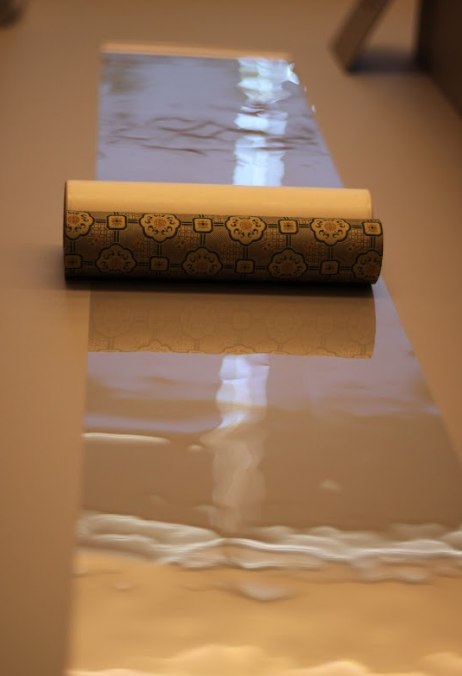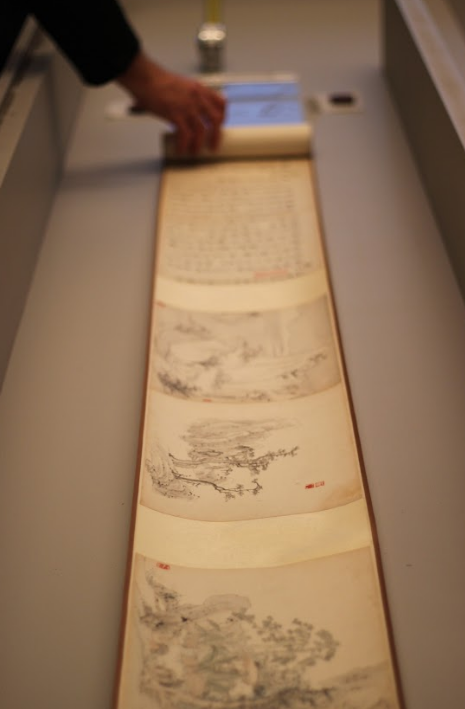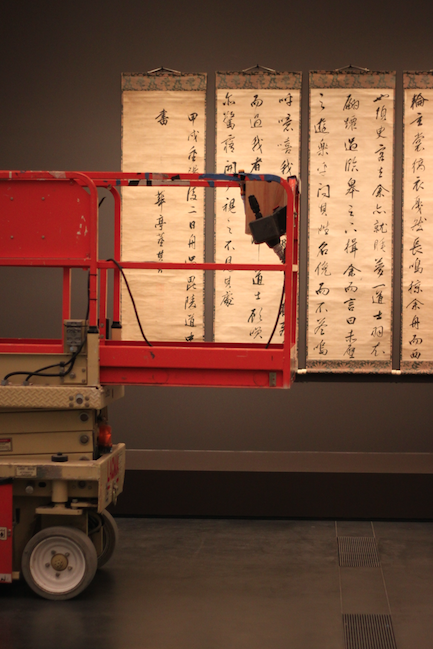I’ve often wondered how many employees it takes to install an exhibition at a large art museum. Prior to my employment with LACMA, I worked for a small museum with a staff size of ten. There, my experience installing exhibitions was a race against the clock while wearing multiple hats and frantically working well into the night before opening our doors to the public.

The installation process for Alternative Dreams: 17th-Century Chinese Painting from the Tsao Family Collection has been a completely different experience. With just two weeks allotted for the installation of over 120 Chinese paintings and covering over 10,000 square feet of exhibition space in the Resnick Pavilion, I was certain there would not be a second to spare.
At a smaller museum, due to constrained resources, I would often do most of the work myself, but at a larger institution like LACMA, the collaboration among multiple departments is essential; services have to be planned and requested weeks in advance. The team, consisting of carpenters, painters, art handlers, graphic designers, registrars, editors, a paper conservator, an exhibition designer, a research assistant, and our department curator, made each day run like a well-oiled machine.
Although the first day of installation began on July 18, the organization of the exhibition started years prior. By the time the exhibition crew arrived on the scene to begin installing, all of the ground work had been completed. The gallery was prepped with freshly painted shades of gray, wall and floor cases were in place, label and wall text had been written, reviewed, and printed, and an exhibition floor plan had been designed to determine where the selection of artwork would be positioned.
The exhibition is divided into nine sections arranged both chronologically and geographically. Included in each section are a collection of handscrolls, which read horizontally, hanging scrolls which hang vertically, fan paintings, and albums consisting of multiple pages referred to as leaves. The installation plan was to start with farthest right corner of the gallery and then work our way through each section and end at the entrance of the show. Luckily, the collection of paintings for this exhibition has been on long-term loan at LACMA since 2012 and housed onsite. Without the time constraint of unpacking crates and taking note of the condition of each piece, preparing the work meant a quick trip to our storage room and transporting the boxed scrolls to the gallery.
Each vertical scroll is contained in a case of either 8, 10 or 12 feet in height. Each case has a plexi cover to protect the artwork. Placement of each encased scroll is overseen by curator Stephen Little. The height is marked with blue painter's tape before a single hook is placed, from which a cord along the top of the mounting is hung and the scroll is carefully unrolled. There is a wooden rod at the bottom, which provides the necessary weight for the painting to hang smoothly. One case after another, one painting at a time, the process repeats.
Chinese scrolls are painted on paper or silk and, depending on the amount of adhesive used in the mounting process to attach the painting to the paper backing, the work can sometimes bow or crease in undesirable ways. This can make leveling the scrolls challenging. Soko Furuhata, our paper conservator, created a number of small tabs to place along the curled sides of the scrolls to flatten the painting for a better viewing experience.


Handscrolls were unrolled horizontally to lay flat in floor cases. Soko prepared each handscroll protected by a layer of Mylar film underneath each scroll to protect it against contact with the painted cases. Magnets were disguised and perfectly placed in position to pin the object securely.
The work is light sensitive, as the ink can fade if left exposed to light for an extended period of time. To minimize light exposure, a layer of film was applied to the outside on the widows in addition to the use of roll down window shades. The lights in the gallery are also dimmed to protect the work. As the opening date neared, multiple jobs took place at once, including the mounting of wall text, patching and painting, and last minute adjustments. The culmination of the largest Chinese painting exhibition LACMA has ever exhibited would not have been possible without numerous contributors who helped to ensure a stunning visual experience.
Alternative Dreams: 17th-Century Chinese Paintings from the Tsao Family Collection is on view in the Resnick Pavilion through December 4, 2016.



